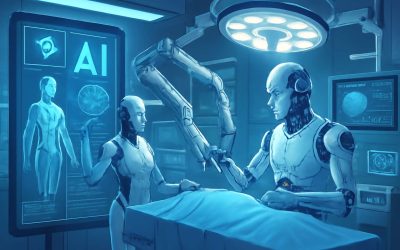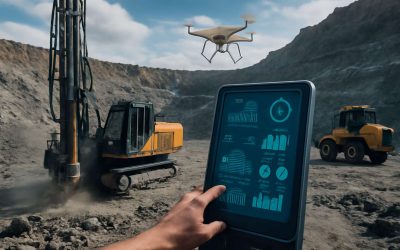Understanding the Fourth Industrial Revolution (4IR)
Defining 4IR – What is the Fourth Industrial Revolution and its core technologies
The Fourth Industrial Revolution (4IR) is not just another buzzword tossed around by tech enthusiasts; it’s the seismic shift that’s transforming industries faster than a cheetah on caffeine. Unlike its predecessors, 4IR integrates cutting-edge technologies that blur the lines between the physical, digital, and biological worlds. This isn’t just about shiny gadgets—it’s a fundamental overhaul of how we work, produce, and innovate.
At its core, 4IR relies on a handful of game-changing technologies such as artificial intelligence, the Internet of Things (IoT), blockchain, and robotics. These innovations enable businesses to operate with unprecedented efficiency, agility, and precision. So, why will 4IR lead to greater productivity? Because it streamlines processes, reduces human error, and unlocks insights that were previously hidden in vast data lakes. Imagine a factory where machines communicate seamlessly, adjusting in real-time — that’s the kind of productivity boost that makes the competition sweat!
Key Technologies Driving 4IR – AI, IoT, Robotics, Blockchain, and More
Understanding the core of the Fourth Industrial Revolution reveals a landscape where technology breathes new life into traditional industries. At the heart of this transformation are key technologies that are reshaping how businesses operate and innovate. Artificial intelligence (AI), the Internet of Things (IoT), robotics, and blockchain are no longer just buzzwords—they are the engines driving efficiency and growth.
AI, for instance, empowers machines to analyze vast amounts of data, enabling smarter decision-making in real-time. Meanwhile, IoT connects devices and systems, creating a web of interconnected operations that communicate seamlessly. Robotics automates repetitive tasks, freeing human workers to focus on creative and strategic pursuits. Blockchain offers transparency and security, reducing delays and errors in transactions.
These technologies work together to streamline processes, minimize human error, and unlock insights buried deep within data lakes. When factories can adapt instantly through machine communication or supply chains become transparent with blockchain, the advantages become clear. This synergy is exactly why will 4IR lead to greater productivity — it transforms the very fabric of how work is done, leading to a future where efficiency is not just improved but revolutionized.
Differences Between Previous Revolutions – Comparing 4IR to 1st, 2nd, and 3rd Industrial Revolutions
The Fourth Industrial Revolution (4IR) does not merely represent an incremental upgrade in technological prowess; it signifies a profound metamorphosis in the very fabric of economic and social systems. Unlike the first industrial revolution, which harnessed water and steam power to mechanize production, or the second, which introduced electrification and mass assembly lines, 4IR integrates digital technologies into a seamless web of interconnected systems. This is not simply about faster machinery—it’s about intelligent systems that learn, adapt, and predict.
Where previous revolutions automated manual tasks, 4IR’s innovations—AI, IoT, and robotics—infuse intelligence into every facet of work. For instance, the automation of routine processes now often involves machine learning algorithms that optimize efficiency without human intervention. This shift underscores why will 4IR lead to greater productivity: it transforms linear workflows into dynamic, responsive ecosystems.
To understand the magnitude of this change, consider the following:
- In the first revolution, productivity gains were primarily driven by mechanization, which increased speed but often lacked flexibility.
- The second revolution introduced economies of scale through electrification, yet still relied heavily on human oversight.
- The third revolution’s digitalization enabled data-driven decision-making, but lacked the interconnectedness that characterizes 4IR.
4IR’s distinctiveness lies in its ability to fuse these advancements, creating an environment where technology amplifies human potential, bolsters efficiency, and paves the way for unprecedented levels of productivity. This evolution is especially pertinent to South Africa’s dynamic economic landscape, where leveraging such transformative technologies can redefine industrial competitiveness and foster sustainable growth. The question is no longer just why will 4IR lead to greater productivity—it has already begun reshaping the future of work with relentless momentum.
How 4IR Enhances Operational Efficiency
Automation of Routine Tasks – Reducing Manual Labor and Human Error
Imagine a world where mundane tasks dissolve into the background, replaced by seamless automation that elevates human potential. This is the promise of the Fourth Industrial Revolution (4IR), transforming industries with unprecedented speed and precision. When considering why will 4IR lead to greater productivity, one of its most compelling facets is the automation of routine tasks. By harnessing advanced technologies like AI and robotics, companies can drastically reduce manual labor and human error, opening the door to innovation and strategic growth.
Automation streamlines workflows, allowing skilled workers to focus on complex problem-solving and creative endeavors. For example, in manufacturing, intelligent machines handle repetitive assembly lines, while human talent is freed for quality control and innovation. This synergy not only accelerates output but also enhances accuracy, minimizing costly mistakes. To fully appreciate the impact, consider how many tasks can be efficiently delegated to automated systems, such as data entry, inventory management, or customer service inquiries.
Real-Time Data Analytics – Making Informed Decisions Faster
In an era where milliseconds matter, the ability to make swift, informed decisions defines the competitive edge. The Fourth Industrial Revolution (4IR) brings this reality into focus through real-time data analytics, fundamentally transforming operational efficiency. By harnessing advanced data processing capabilities, organizations can convert vast streams of information into actionable insights instantaneously. This rapid access to critical data enables companies to respond to market shifts, supply chain disruptions, or customer needs with unparalleled agility.
For instance, in South Africa’s dynamic industries, real-time analytics empower businesses to optimize production schedules, manage inventory precisely, and anticipate maintenance needs before costly failures occur. This continuous flow of insights fosters a culture of proactive management, reducing downtime and operational costs. When combined with the strategic deployment of IoT devices and AI, real-time data analytics becomes a catalyst for sustained productivity growth. It’s no wonder that the question of why will 4IR lead to greater productivity is increasingly rooted in the ability to make faster, smarter decisions—turning data into a decisive advantage.
Supply Chain Optimization – Leveraging IoT and AI for Seamless Logistics
In the vibrant tapestry of South Africa’s bustling industries, the integration of Fourth Industrial Revolution (4IR) technologies is transforming supply chain logistics into a symphony of seamless efficiency. Imagine a world where every movement, every shipment, and every inventory count is orchestrated with precision, guided by the invisible hand of IoT and AI. This is not mere fantasy but a tangible reality unfolding before our eyes.
By leveraging IoT sensors embedded in transportation fleets and warehouse infrastructure, companies gain real-time visibility into their operations. This connectivity ensures that disruptions are addressed proactively, routes are optimized instantaneously, and inventory levels are managed with remarkable accuracy. When paired with AI-driven predictive analytics, supply chains become resilient and adaptive, capable of responding swiftly to market fluctuations or unforeseen challenges.
- Enhanced tracking of goods from origin to destination
- Dynamic rerouting to avoid delays
- Precise inventory management reducing excess stock
Such innovations do more than just streamline logistics—they create a ripple effect of productivity gains across sectors. The question of why will 4IR lead to greater productivity becomes clearer: it’s rooted in the ability to harness digital intelligence for smarter, faster decisions, transforming complex supply chains into models of agility and reliability. Truly, this technological renaissance is paving the way for a future where operational efficiency is not just an aspiration but a standard.
Boosting Innovation and Product Development
Accelerated R&D Cycles – Using Digital Twins and Simulation Technologies
Imagine a world where innovation isn’t just a spark of inspiration but a meticulously orchestrated dance of technology and insight. The fourth industrial revolution, or 4IR, is transforming how companies approach product development, significantly accelerating R&D cycles. One of the game-changing tools in this era is the use of digital twins and simulation technologies. These virtual replicas of physical assets allow engineers and designers to experiment, test, and optimize in a risk-free environment, drastically reducing the time needed for prototypes and testing phases.
By harnessing these advanced simulation tools, businesses can identify flaws early and iterate faster, leading to more innovative products reaching the market in record time. This accelerated process not only boosts productivity but also provides a competitive edge in a rapidly evolving landscape. When companies leverage digital twins, they gain a clearer understanding of product performance and customer needs, fostering an environment where innovation flourishes. So, why will 4IR lead to greater productivity? Because it empowers organizations to innovate smarter, faster, and more effectively than ever before!
Customization and Personalization – Meeting Consumer Demands with Flexibility
In a world where consumer desires evolve at the speed of thought, the fourth industrial revolution emerges as the master key to unlocking unparalleled levels of innovation and customization. Companies no longer merely produce; they craft tailored experiences that resonate deeply with individual needs. This era’s technological prowess enables organizations to meet consumer demands with remarkable flexibility, transforming static products into dynamic solutions.
With the advent of advanced manufacturing and digital integration, businesses can now adapt their offerings on the fly, creating bespoke products that reflect personal preferences. Imagine a world where product development is no longer a linear journey but a fluid dance of real-time insights and agile adjustments. This ability to personalize at scale is a cornerstone of why will 4ir lead to greater productivity, as it fosters customer loyalty and diminishes wasteful overproduction.
- Leveraging data analytics to understand nuanced consumer behaviors.
- Utilizing flexible manufacturing processes to tailor products swiftly.
- Implementing AI-driven design tools that adapt to individual specifications.
Such technological symphony not only accelerates innovation but also amplifies the efficacy of resource deployment. As companies embrace this transformative wave, the boundaries of traditional manufacturing dissolve, giving way to a future where customization and productivity walk hand in hand—proving definitively that 4IR is the catalyst for a profoundly more efficient and responsive marketplace.
Fostering Creative Collaboration – Remote Work Tools and Digital Platforms
In a world where ideas germinate at the speed of light and collaboration transcends borders, the fourth industrial revolution ignites a symphony of innovation. The question lingers: why will 4ir lead to greater productivity? The answer lies in the seamless fusion of creative minds and cutting-edge technology, transforming the way we develop and refine ideas. With digital platforms and remote work tools, teams can now forge connections that defy geographical constraints, unleashing a torrent of ingenuity.
Imagine a digital canvas where collaboration flows as effortlessly as a river, sculpted by cloud-based solutions and real-time communication channels. These tools foster an environment ripe for brainstorming, iteration, and rapid prototyping—accelerating product development cycles and nurturing a culture of continuous innovation. As organizations harness this digital renaissance, they unlock boundless potential for creative breakthroughs, making productivity soar to unprecedented heights.
Furthermore, the integration of AI-driven platforms and virtual collaboration spaces catalyzes a new era of synergy. Teams can work asynchronously yet harmoniously, blending diverse perspectives into cohesive solutions. This interconnectedness not only sparks fresh ideas but also streamlines workflows, proving that in the realm of the 4IR, collaboration is no longer confined by physical borders but expanded into a global tapestry of shared human ingenuity.
Improving Workforce Productivity through 4IR
Upskilling and Reskilling – Preparing Employees for New Technologies
As the dawn of the Fourth Industrial Revolution unfolds, it’s evident that traditional workforce paradigms are being redefined at an astonishing pace. The question isn’t just why will 4IR lead to greater productivity; it’s how organizations can harness this seismic shift to unlock their true potential. By embracing upskilling and reskilling, companies empower their employees to navigate the labyrinth of emerging technologies with confidence and agility.
In this new era, skills acquisition becomes a vital enchantment—transforming workers from mere operators into innovative pioneers. Investing in continuous learning ensures that staff can master tools like AI-driven analytics, IoT integration, and robotics, which are the keystones of 4IR. As a result, businesses not only streamline operations but also foster a culture of inventive problem-solving. This dynamic ecosystem accelerates decision-making and propels productivity to heights previously thought unattainable.
- Enhanced adaptability to technological change
- Improved decision-making through real-time data insights
- Greater efficiency in routine and complex tasks
- Stronger competitive advantage in a digital economy
When employees are prepared for the rapid tide of innovation, organizations stand to flourish amidst the chaos of transformation. The magic of upskilling and reskilling in the context of 4IR is, therefore, the catalyst that ignites sustained productivity and growth, making it not just a strategic choice but a necessity for thriving in tomorrow’s world.
Enhanced Workforce Flexibility – Remote Work and Cloud Solutions
The Fourth Industrial Revolution is transforming the very fabric of how we work, offering unprecedented flexibility that can elevate productivity to soaring heights. Remote work, once a perk, has now become a strategic pillar in the modern workspace—empowering employees to collaborate seamlessly across distances. Cloud solutions amplify this connectivity, enabling real-time access to vital data and tools, regardless of location. This digital agility fosters a resilient workforce capable of adapting swiftly to market shifts and operational demands.
By embracing these innovations, organizations harness the full potential of their human capital. Consider the advantages:
- Enhanced workforce flexibility that accommodates diverse work styles and geographic locations
- Improved collaboration through digital platforms that transcend physical boundaries
- Accelerated task completion and decision-making via instant access to cloud-based resources
When employees can work effectively from anywhere, businesses experience a surge in productivity that is both sustainable and scalable. This fluidity not only optimizes daily operations but also fuels a culture of innovation and resilience—crucial in today’s rapidly evolving digital economy. The ability to seamlessly integrate remote work and cloud solutions is a cornerstone of why will 4ir lead to greater productivity, unlocking new levels of efficiency and competitive edge for South African organizations navigating the future.
Employee Engagement – Using Digital Tools for Better Collaboration
In an era where the pace of change makes a cheetah look sluggish, leveraging digital tools for employee engagement has never been more crucial. The Fourth Industrial Revolution (4IR) is revolutionizing how teams collaborate—no longer confined by physical boundaries or antiquated communication channels. Instead, organizations are embracing innovative digital platforms that facilitate seamless interaction, fostering a culture of shared purpose and agility.
When employees are empowered with real-time collaboration tools—think instant messaging, project management apps, and virtual whiteboards—they become more engaged and productive. These tools not only streamline workflows but also cultivate a sense of community, even across distant geographies. This is vital in South Africa, where diverse workforces span urban centers and rural areas alike.
Here’s a quick glance at how digital engagement boosts productivity:
- Breaking down communication silos for more transparent decision-making
- Reducing delays by enabling instantaneous feedback and updates
- Encouraging innovation through collaborative brainstorming sessions online
By integrating these digital tools, organizations are not merely keeping pace with the 4IR but harnessing its power to dramatically increase productivity. It’s a win-win: happier employees, faster results, and a competitive edge that’s hard to beat in today’s digital economy. Truly, understanding why will 4IR lead to greater productivity is fundamental for South African companies aiming to thrive amidst relentless technological evolution.
Cost Reduction and Revenue Growth
Lower Operational Costs – Automation and Energy Efficiency
In a world racing toward innovation, the fourth industrial revolution (4IR) emerges as a catalyst for unparalleled efficiency. One of its most compelling virtues is cost reduction, a symphony of automation and energy efficiency that transforms the operational landscape. Imagine factories humming with intelligent machines that not only perform tasks faster but do so with minimal energy consumption, slashing expenses and environmental impact alike. This shift isn’t just about saving money—it’s about unlocking new avenues for growth.
Lower operational costs are the foundation for expansive revenue growth. By integrating advanced technologies like IoT and AI, businesses can streamline processes, eliminate waste, and optimize resource use in real time. For instance, predictive maintenance prevents costly downtimes, and smart energy management reduces utility bills. The question of why will 4IR lead to greater productivity is answered through these tangible savings, paving the way for reinvestment and innovation. When companies harness these digital efficiencies, they do more than survive—they thrive in a fiercely competitive market!
New Business Models – Platform Economies and Subscription Services
In the shadowed corridors of progress, a new realm emerges—an era where traditional boundaries dissolve into the digital mist. The question lingers: why will 4IR lead to greater productivity? The answer lies in the metamorphosis of business models—an evolution driven by platform economies and subscription services that reshape how value is created and captured.
By harnessing the power of interconnected platforms, companies can unlock new revenue streams while fostering seamless customer engagement. Subscription models, for instance, transform one-time transactions into continuous revenue flows, ensuring stability and ongoing innovation. This shift allows businesses to adapt swiftly to market demands, fueling a cycle of relentless growth and efficiency.
- Enhanced scalability through digital ecosystems
- Steady income via recurring subscriptions
- Deeper customer insights for tailored offerings
Ultimately, these digital business models are not merely a means of survival but a pathway to extraordinary productivity, where technological prowess and strategic foresight intertwine. The question remains—why will 4IR lead to greater productivity? Because it rewires the very fabric of commerce itself, unleashing an unstoppable tide of innovation and resilience.
Expanding Market Reach – Global Accessibility Enabled by Digital Tech
In an era where digital transformation is reshaping the business landscape, the question of why will 4IR lead to greater productivity remains more relevant than ever. As companies harness cutting-edge technologies like AI, IoT, and blockchain, they unlock unprecedented opportunities for cost reduction and revenue growth. These innovations streamline operations, eliminate waste, and optimize resource allocation—fundamental drivers of increased productivity.
Furthermore, digital tech extends a borderless marketplace, enabling businesses to expand their market reach globally. From South Africa to distant shores, companies now access a broader customer base with ease. This global accessibility not only boosts sales but also diversifies revenue streams, reinforcing resilience. For instance, e-commerce platforms powered by advanced digital infrastructure allow local enterprises to compete on international stages without physical boundaries.
To illustrate, consider the following advantages of digital ecosystems:
- Lower operational costs through automation and energy efficiency
- Enhanced market penetration with digital marketing and e-commerce channels
- Real-time insights into customer behavior, enabling tailored offerings
- Flexible business models that adapt swiftly to changing demands
By weaving these elements together, why will 4IR lead to greater productivity? The answer lies in its ability to connect markets, optimize processes, and foster innovation—fueling growth in ways previously unimagined. This digital revolution doesn’t just change how business is done; it redefines the very limits of what is possible. And in doing so, it propels organizations toward extraordinary heights of efficiency and success.
Addressing Challenges and Ensuring Sustainable Productivity
Cybersecurity Aspects – Protecting Digital Assets
As the digital winds of the Fourth Industrial Revolution sweep across South Africa, the question isn’t just about technological advancement but about safeguarding our digital future. The rapid pace of innovation brings unparalleled opportunities for productivity, yet it also ushers in complex cybersecurity challenges. Protecting digital assets becomes paramount in ensuring that the gains of 4IR are sustainable and resilient against evolving threats. Without robust cybersecurity measures, the very foundation of this revolution—data integrity and trust—can be compromised, undermining the potential for greater productivity.
Addressing these challenges requires a strategic approach that combines cutting-edge security protocols with proactive monitoring. For example, implementing layered security architectures and continuous threat assessment can shield vital information from cyberattacks. As we explore why will 4IR lead to greater productivity, it’s essential to recognize that security isn’t an afterthought but an integral part of the digital transformation journey. Only then can businesses confidently harness the full power of 4IR to drive innovation and economic growth, ensuring that our digital assets remain protected and our productivity continues to soar.
Managing Technological Disruption – Change Management Strategies
Addressing the challenges brought about by the Fourth Industrial Revolution requires more than just technological upgrades—it demands a strategic approach to change management. As businesses in South Africa embrace 4IR, managing technological disruption becomes critical to sustain momentum and maximize productivity. Resistance to change can undermine progress, but with effective strategies in place, organizations can navigate the complexities and unlock the full potential of 4IR.
One key element is fostering a culture of agility and continuous learning. This involves engaging employees at all levels, encouraging adaptation, and minimizing fear of the unknown. A well-structured change management plan helps smooth the transition, ensuring that innovations like AI, IoT, and automation are integrated seamlessly into daily operations. When companies proactively manage technological disruption, they position themselves to respond quickly to market shifts and emerging opportunities.
- Develop clear communication channels to keep everyone informed about new processes and goals.
- Invest in reskilling initiatives to empower staff with the skills needed for digital workflows.
- Implement phased rollouts of new systems to allow gradual adaptation and minimize operational hiccups.
By managing technological disruption effectively, businesses in South Africa can accelerate their journey towards greater productivity. This proactive stance not only mitigates risks but also cultivates resilience, turning change into a catalyst for innovation and growth. The question isn’t just why will 4IR lead to greater productivity—it’s how well we manage the transition to ensure those gains are sustainable and far-reaching.
Ensuring Inclusivity – Bridging Digital Divides
Addressing the challenges posed by the Fourth Industrial Revolution requires more than technological innovation; it demands a nuanced approach to ensure sustainable productivity. In South Africa’s dynamic landscape, bridging digital divides becomes paramount, especially when considering why will 4IR lead to greater productivity. Without deliberate efforts to include marginalized communities and equip all sectors with digital skills, the gains risk being uneven and fleeting.
Ensuring inclusivity involves creating pathways for equitable access to emerging technologies, fostering a resilient economy that benefits everyone. This can be achieved through targeted reskilling initiatives and infrastructure investments that reach rural and underserved areas. When digital divides are bridged, organizations reinforce their social license to innovate and grow, making the benefits of 4IR more widespread and impactful.
Furthermore, addressing these disparities minimizes resistance and cultivates a culture of collective progress. As industries adopt automation, AI, and IoT solutions, their success hinges on a workforce prepared to embrace change. The question remains—why will 4IR lead to greater productivity if inclusivity is not prioritized? Because sustainable growth emerges only when technological advancement is democratized and accessible to all, transforming potential into tangible, lasting gains.




0 Comments